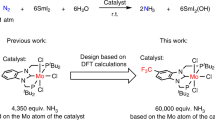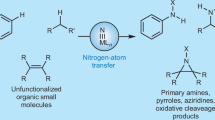Abstract
Molecular nitrogen (N2) and carbon monoxide (CO) have the two strongest bonds in chemistry and present significant challenges in developing new transformations that exploit these two abundant feedstocks. At the core of this objective is the discovery of transition-metal compounds that promote the six-electron reductive cleavage of N2 at ambient temperature and pressure and also promote new nitrogen–element bond formation. Here we show that an organometallic hafnium compound induces N2 cleavage on the addition of CO, with a simultaneous assembly of new nitrogen–carbon and carbon–carbon bonds. Subsequent addition of a weak acid liberates oxamide, which demonstrates that an important agrochemical can be synthesized directly from N2 and CO. These studies introduce an alternative paradigm for N2 cleavage and functionalization in which the six-electron reductive cleavage is promoted by both the transition metal and the incoming ligand, CO, used for the new bond formations.
This is a preview of subscription content, access via your institution
Access options
Subscribe to this journal
Receive 12 print issues and online access
$259.00 per year
only $21.58 per issue
Buy this article
- Purchase on Springer Link
- Instant access to full article PDF
Prices may be subject to local taxes which are calculated during checkout






Similar content being viewed by others
References
Ertl, G. Reactions at surfaces: from atoms to complexity (Nobel Lecture). Angew. Chem. Int. Ed. 47, 3524–3535 (2008).
Smil, V. Enriching the Earth: Fritz Haber, Carl Bosch, and the Transformation of World Food Production (MIT Press, 2001).
Holladay, J. D., Hu, J., King, D. L. & Wang, Y. An overview of hydrogen production technologies. Catal. Today 139, 244–260 (2009).
Thomas, J. M. & Thomas, W. J. Fischer–Tropsch Catalysis, in Principles and Practice of Heterogeneous Catalysis (VCH, 1996).
Macho, V., Kralik, M. & Komora, L. Progress in commercial and potential industrial processes based on carbon monoxide. Petrol. Coal 39, 6–12 (1997).
MacLachlan, E. A. & Fryzuk, M. D. Synthesis and reactivity of side-on-bound dinitrogen metal complexes. Organometallics 25, 1530–1543 (2006).
Pool, J. A., Lobkovsky, E. & Chirik, P. J. Hydrogenation and cleavage of dinitrogen to ammonia with a zirconium complex. Nature 427, 527–530 (2004).
Fryzuk, M. D., Love, J. B. & Rettig, S. J. Transformation of coordinated dinitrogen by reaction with dihydrogen and primary silanes. Science 275, 1445–1447 (1997).
Pun, D., Bradley, C. A., Lobkovsky, E., Keresztes, I. & Chirik, P. J. N2 hydrogenation from activated end-on bis(indenyl) zirconium dinitrogen complexes. J. Am. Chem. Soc. 130, 14046–14047 (2008).
Bernskoetter, W. H., Lobkovsky, E. & Chirik, P. J. Kinetics and mechanism of N2 hydrogenation in bis(cyclopentadienyl) zirconium complexes and dinitrogen functionalization by 1,2-addition of a saturated C–H bond. J. Am. Chem. Soc. 127, 14051–14061 (2005).
Bernskoetter, W. H., Pool, J. A., Lobkovsky, E. & Chirik, P. J. Dinitrogen functionalization with terminal alkynes, amines, and hydrazines promoted by [(η5-C5Me4H)2Zr]2(μ2,η2,η2-N2): observation of side-on and end-on diazenido complexes in the reduction of N2 to hydrazine. J. Am. Chem. Soc. 127, 7901–7911 (2005).
Bernskoetter, W. H., Olmos, A. V., Lobkovsky, E. & Chirik, P. J. N2 hydrogenation promoted by a side-on bound hafnocene dinitrogen complex. Organometallics 25, 1021–1027 (2006).
Morello, L., Love, J. B., Patrick, B. O. & Fryzuk, M. D. Carbon–nitrogen bond formation via the reaction of terminal alkynes with a dinuclear side-on dinitrogen complex. J. Am. Chem. Soc. 126, 9480–9481 (2004).
Bernskoetter, W. H., Olmos, A. V., Pool, J. A., Lobkovsky, E. & Chirik, P. J. N–C bond formation promoted by a hafnocene dinitrogen complex: comparison of zirconium and hafnium congeners. J. Am. Chem. Soc. 128, 10696–10697 (2006).
Bernskoetter, W. H., Lobkovsky, E. & Chirik, P. J. Nitrogen–carbon bond formation from N2 and CO2 promoted by a hafnocene dinitrogen complex yields a substituted hydrazine. Angew. Chem. Int. Ed. 46, 2858–2861 (2007).
Knobloch, D. J., Toomey, H. E. & Chirik, P. J. Carboxylation of an ansa-zirconocene dinitrogen complex: regiospecific hydrazine synthesis from N2 and CO2 . J. Am. Chem. Soc. 130, 4248–4249 (2008).
Hanna, T. E., Keresztes, I., Lobkovsky, E. & Chirik, P. J. Diazene dehydrogenation follows H2 addition to coordinated dinitrogen in an ansa-zirconocene complex. Inorg. Chem. 46, 1675–1683 (2007).
Hirotsu, M., Fontaine, P. P., Zavalij, P. Y. & Sita, L. R. Extreme N≡N bond elongation and facile N-atom functionalization reactions within two structurally versatile new families of group 4 bimetallic ‘side-on-bridged’ dinitrogen complexes for zirconium and hafnium. J. Am. Chem. Soc. 129, 12690–12692 (2007).
Roesky, H., Amin, N., Remmers, G., Gieren, A. & Dederer, B. Formal criss-cross cycloaddition of sulfur trioxide to cyanogen. Angew. Chem. Int. Ed. Engl. 18, 223 (1979).
Laplaza, C. E. & Cummins, C. C. Dinitrogen cleavage by a three-coordinate molybdenum(iii) complex. Science 268, 861–863 (1995).
Laplaza, C. E. et al. Dinitrogen cleavage by three-coordinate molybdenum(iii) complexes: mechanistic and structural data. J. Am. Chem. Soc. 118, 8623–8638 (1996).
Curley, J. J., Cook, T. R., Reece, S. Y., Müller, P. & Cummins, C. C. Shining light on dinitrogen cleavage: structural features, redox chemistry, and photochemistry of the key intermediate bridging dinitrogen complex. J. Am. Chem. Soc. 130, 9394–9405 (2008).
McKay, B. A. & Fryzuk, M. D. Dinitrogen coordination chemistry: on the biomimetic borderlands. Chem. Rev. 104, 385–401 (2004).
Fryzuk, M. D. Side-on end-on bound dinitrogen: an activated bonding mode that facilitates functionalizing molecular nitrogen. Acc. Chem. Res. 42, 127–133 (2009).
Curley, J. J., Sceats, E. L. & Cummins, C. C. A cycle for organic nitrile synthesis via dinitrogen cleavage. J. Am. Chem. Soc. 128, 14036–14037 (2006).
Akagi, F., Matsuo, T. & Kawaguchi, H. Dinitrogen cleavage by a diniobium tetrahydride complex: formation of a nitride and its conversion into imide species. Angew. Chem. Int. Ed. 46, 8778–8781 (2007).
Chatt, J., Pearman, A. J. & Richards, R. L. Conversion of dinitrogen in its molybdenum and tungsten complexes into ammonia and possible relevance to nitrogenase reaction. J. Chem. Soc. Dalton Trans. 1852–1860 (1977).
Yandulov, D. V. & Schrock, R. R. Catalytic reduction of dinitrogen to ammonia at a single molybdenum center. Science 301, 76–78 (2003).
Schrock, R. R. Catalytic reduction of dinitrogen to ammonia at a single molybdenum center. Acc. Chem. Res. 38, 955–962 (2005).
Mori, M. Synthesis of nitrogen heterocycles utilizing molecular nitrogen as a nitrogen source and attempt to use air instead of nitrogen gas. Heterocycles 78, 281–318 (2009).
Nikiforov, G. B., Vidyaratne, I., Gambarotta, S. & Korobkov, I. Titanium-promoted dinitrogen cleavage, partial hydrogenation, and silylation. Angew. Chem. Int. Ed. 48, 7415–7419 (2009).
Watanabe, T., Ishida, Y., Matsuo, T. & Kawaguchi, H. Reductive coupling of six carbon monoxides by a ditantalum hydride complex. J. Am. Chem. Soc. 131, 3474–3475.
Summerscales, O. T., Cloke, F. G. N., Hitchcock, P. B., Green, J. C. & Hazari, N. Reductive cyclotrimerization of carbon monoxide to the deltate dianion by an organometallic uranium complex. Science 311, 829–831 (2006).
Herrmann, H., Fillol, J. L., Wadepohl, H. & Gade, L. H. A zirconium (1-pyridinio)imido complex: facile N–N bond cleavage and N–C bond formation. Organometallics 27, 172–174 (2008).
Herrmann, H., Fillol, J. L., Wadepohl, H. & Gade, L. H. A zirconium hydrazide as a synthon for a metallanitrene equivalent: atom-by-atom assembly of [EN2]2− units (E = S, Se) by chalcogen-atom transfer in the coordination sphere of a transition metal. Angew. Chem. Int. Ed. 46, 8426–8430 (2007).
Selby, J. D. et al. New ligand platforms for developing the chemistry of the Ti=N–NR2 functional group and the insertion of alkynes into the N–N bond of a Ti=N–NPh2 ligand. Chem. Commun. 4937–4939 (2007).
Walsh, P. J., Carney, M. J. & Bergman, R. G. Generation, dative ligand trapping, and nitrogen–nitrogen bond cleavage reactions of the first monomeric η1-hydrazido zirconocene complex, (Cp2Zr = NNPh2). A zirconium mediated synthesis of indoles. J. Am. Chem. Soc. 113, 6343–6345 (1991).
Fagan, F. J. et al. Insertion of carbon monoxide into metal–nitrogen bonds. Synthesis, chemistry, structures, and structural dynamics of bis(pentamethylcyclopentadienyl) organoactinide dialkylamides and η2-carbamoyls. J. Am. Chem. Soc. 103, 2206–2220 (1981).
Petz, W., Weller, F. & Avtomonov, E. V. Carbonyl insertion into zirconium–nitrogen bonds; synthesis and X-ray structure of a carbene complex composed of [Zr(NMe2)4]2 and three Fe(CO)5 units containing Fe → Zr donor–acceptor interactions. J. Organomet. Chem. 598, 403–408 (2000).
Duncan, A. P. & Bergman, R. G. Selective transformations of organic compounds by imidozirconocene complexes. Chem. Rec. 2, 431–445 (2002).
Acknowledgements
Financial support was provided by the Director, Office of Basic Energy Sciences, Chemical Sciences Division, of the US Department of Energy (DE-FG02-05ER15659) and the Frasch Foundation administered by the American Chemical Society.
Author information
Authors and Affiliations
Contributions
D.J.K. and P.J.C. conceived and designed the concepts and experiments. D.J.K. carried out the experiments, E.L. collected and solved the X-ray diffraction data and P.J.C. and D.J.K co-wrote the manuscript.
Corresponding author
Ethics declarations
Competing interests
The authors declare no competing financial interests.
Supplementary information
Supplementary information
Supplementary information (PDF 496 kb)
Supplementary information
Crystallographic data for compound 2-N2 (corrected 8 January 2010) (CIF 24 kb)
Supplementary information
Crystallographic data for compound 2-N2C2O2 (CIF 26 kb)
Supplementary information
Crystallographic data for compound 3 (CIF 24 kb)
Rights and permissions
About this article
Cite this article
Knobloch, D., Lobkovsky, E. & Chirik, P. Dinitrogen cleavage and functionalization by carbon monoxide promoted by a hafnium complex. Nature Chem 2, 30–35 (2010). https://doi.org/10.1038/nchem.477
Received:
Accepted:
Published:
Issue Date:
DOI: https://doi.org/10.1038/nchem.477
This article is cited by
-
Direct synthesis of oxalic acid via oxidative CO coupling mediated by a dinuclear hydroxycarbonylcobalt(III) complex
Nature Communications (2023)
-
Direct synthesis of cyanate anion from dinitrogen catalysed by molybdenum complexes bearing pincer-type ligand
Nature Communications (2022)
-
Synthesis of arylamines and N-heterocycles by direct catalytic nitrogenation using N2
Nature Communications (2021)
-
Metallacyclic actinide catalysts for dinitrogen conversion to ammonia and secondary amines
Nature Chemistry (2020)
-
Coupling dinitrogen and hydrocarbons through aryl migration
Nature (2020)



